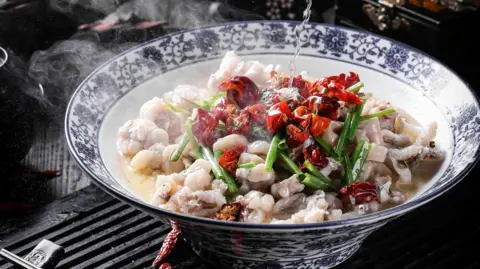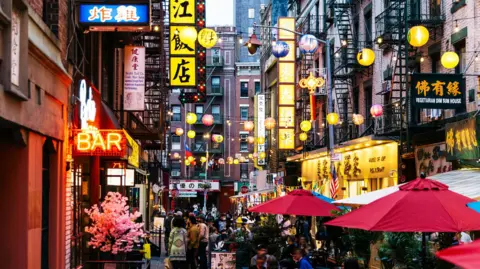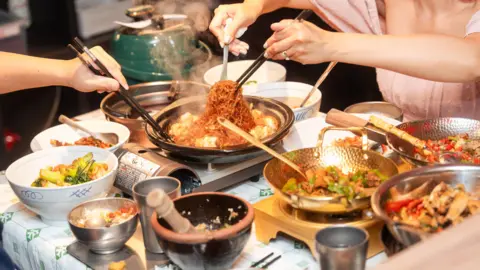BBC News, Singapore
 Getty images
Getty imagesGrilled fish on a generous bed of peppers and pepper grains from the southwest metropolis of China, Chongqing; Xinjiang cumin milk lamb skewers in the extreme north; And ardent rice noodles flavored with snails of the famous Guangxi rivers in the south.
All this on a walk on Liang Seah Street in Singapore.
Chinese food has a moment outside China, led by huge success and intense competition at home. And nowhere more clearly than Singapore, where ethnically Chinese represent more than three -quarters of the multicultural population.
The trend is not surprising since the Chinese soft power seems to be increasing – think of viral labubu dolls, humanoid robots and futuristic cities that impress travelers.
Centuries and sophisticated, Chinese cuisine is not among the list of Beijing priorities to transform the country into “a power in culture” by 2035.
And yet, while a increasingly authoritarian China strives to win the whole world, a sumptuous table can be its most efficient and underestimated draw.
First judgment: Singapore
Luckin, China’s response to Starbucks, opened its first store abroad in Singapore in March 2023. Two years later, there were more than 60. Last month, the channel made its debut in the United States with two New York stores.
Five major Chinese brands, Luckin included, currently perform 124 points of sale in Singapore, the double of the number they owned in 2023. It is difficult to miss the evidence: enormous light announcements of chili dishes and, sometimes, Chinese idioms, in shopping centers, buses and metro stations.
From channels established at Maman-et-Pop stores and chic restaurants that challenge tired stereotypes, they all decorated here before jumping further, to Southeast Asia, then around the world.
Succeeding in Singapore is “proof of concept for a subsequent expansion, convincing the potential investors that the chain is ready to globalize,” explains Thomas Dubois, historian of modern China.

It is a fairly easy place for new restaurants to settle down. And it is diversified, which makes it excellent test cuisine for very different palaces, from South Asia to Europe.
And above all, Singapore is a travel center where, says Dubois, eating is almost like a national hobby: “People go to Singapore to eat.”
And what they will find are menus that go beyond the omnipresent dumplings and the hot pot. Entrepreneurs behind the new Chinese culinary wave want to show people how large and diverse China is. And they cannot simulate.
Many visitors from Singapore are ethnic Chinese – not only from China, but from Bangkok, Kuala Lumpur, Manila, Jakarta and so on – with a sophisticated understanding of Chinese cuisine.
There is no one fiery, explains Claire Wang, marketing director of Nong Geng Ji, a chain of Hunan in the center of China, famous for her spicy dishes.
Hunan’s price has “an acidic afloat made thanks to fermented peppers”, she says, unlike “Sichuan’s Numbing-Spicy or Guizhou’s Sour-Spicy”.
After having launched more than 100 restaurants in China, Nong Geng Ji opened his first stop abroad in Singapore at the end of 2023. Since then, he has installed six others here, five in Malaysia, one in Canada, and is now considering opportunities in Thailand, Japan, South Korea and the United States.
This is certainly proof of the growing appetite for peppers, in particular the Chinese type – a trend that would appeal to the former chief of China Mao Zedong. Born and raised in Hunan, he believed: “You cannot be a revolutionary if you do not eat peppers”.
Finally, “appropriate” Chinese food
At the very least revolutionary among us, there is much more on the table: steamed buns, red meats, preserved vegetables, rice, seasonal jums and delicately savored seafood.
It is quite the spread compared to “Chinese food” that a large part of the world has been used, especially in the West – food prepared by Chinese immigrants in the 19th and 20th centuries, whose brushy indescriptible restaurants were often considered at low content.
 Getty images
Getty imagesFood has been simplified to adapt to local tastes, and this is how the United States found themselves with non-Chinese staples such as Orange chicken and Suey Chop, and the United Kingdom with its Chow Mein and Sweet and Sour chickens.
These very basic and largely invented dishes “appreciated the diversity and sophistication of Chinese gastronomic culture”, writes Fuchsia Dunlop in his new book, invitation to a banquet. Ms. Dunlop, a British food writer, spent her career in Chinese kitchens and studying her food.
Then there is stereotype, nicknamed the Chinese restaurant syndrome, a partially xenophobic myth according to which food can make people sick due to an supposed concentration of additives, in particular the flavoring agent MSG. New research suggests that MSG does not make you sick, and although older Chinese restaurants have probably used shortcuts to savor, they were hardly unique in the use of additives.
Now, a growing diaspora allows Chinese restaurants to stay faithful to their roots, knowing that they have customers demanding “an appropriate Chinese cuisine”. And that coincided with more adventurous palaces in the largest cities in the world.
When Thomas Tao was a student in New York in the 2010s, he said that he rarely met Chinese gastronomy, but the Americans were very willing to pay, let’s say, Japanese sashimis.
Now, he is the vice-president of the Green Tea restaurant chain, which has more than 400 points of sale in China in the service of fresh seafood and salty soups in Zhejiang. He will open his first outpost in Singapore later this month.
And it goes beyond food, with “immersive” restaurants. The guests listen to the Guzheng, a Chinese zare, while they sit at boat -shaped tables surrounded by landscapes around Lake West, an icon in the coastal province.
“We want to help people accept our culture more and correct the idea that Chinese cuisine is” ugly “,” says Tao.
 No Geng Ji
No Geng JiThis is not the only channel to try this. Sichuan Alley, who opened his first point of sale in New York last year, is inspired by the “alley culture” characteristic of the early 20th century Chengdu – a warren of old streets where people mix and feast.
Food tells the story of a people and unless you visit a place, it may be the best overview.
The Chinese table can therefore help soften the image of a country whose ambitions often come up against those of Western powers and neighbors?
The price of soft power
In his book, Dunlop quotes one of his readers suggesting that Beijing could more effectively project his soft power by “changing his controversial Confucius institutes abroad in Chinese first -rate restaurants”.
Beijing fights a lot on the international front: Trump’s prices, alleged spy plots and a world that is wary of its economic power.
Even this explosion in Chinese restaurant channels worries local businesses in Singapore who wonder if they can follow.
Strong competition in China and a drop in spending force these chains abroad. And their rhythm of expansion is insatiable – they bring with them a reliable supply chain, a sense of marketing and deep pockets which allow them to sacrifice the profit.
And they have a game book. You are first encouraged to register for a free subscription that allows you to put back. Meals are delivered with a flow of tea, soaked sauces and marinated vegetables.
The winner? Unlike most Singaporean restaurants, fabrics – much necessary after a spicy meal – are free.
This is not the first time that exports of China’s success has aroused anxiety in its small neighbors in Southeast Asia. This has already occurred with many Chinese imports, gadget clothes.
But food, some people believe, can soften this case.
“The Chinese are very proud of their culinary culture, which also serves as a powerful form of diplomacy”, explains Felix Ren, director of the food firm based in Singapore Wemedia.
He was encouraged by table tennis matches that helped to thaw historical tensions between Beijing and Washington in 1971.
“Chinese cuisine,” he said, “could be the new ping-pong diplomacy.”



